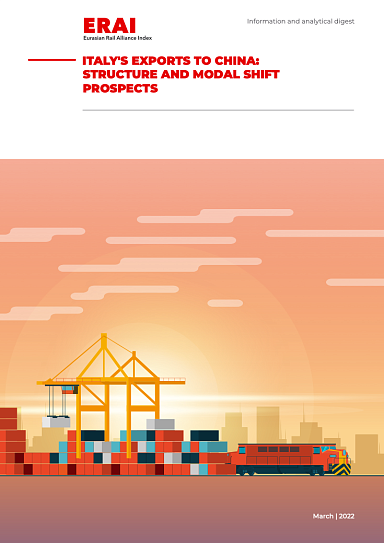China is one of the European Union’s key partners. In 2020 it became the main trading partner thereof. At the same time, one of China’s key partners among the Union is Italy. In 2020, bilateral trade between these countries exceeded EUR 45 billion, of which nearly EUR 13 billion came from Italian exports to China. Similarly to other EU countries, Italy has a negative balance in trade with China: in 2020 it was about EUR 19.4 billion, and in January-October 2021 — EUR 18.5 billion (EUR 17 billion in the same period last year). The current balance of Italian exports/imports demonstrates challenges for the transport industry, and makes it relevant to consider Italy’s exports as well as prospects for its modal shift.
Due to the COVID-crisis, which hit the country hardest, Italy’s GDP fell by almost 9% in 2020. At the end of 2021, GDP is projected to recover by 6.3%. The EU Recovery Fund, of which Italy will be the main beneficiary, will also contribute to resilience of its economy. Thus, we should expect an accelerated rate of economic growth in 2022, and, consequently, of exports. The current situation could be an additional incentive to accelerate the modal shift in favor of railroads.
Specific feature of Italy is the imbalance between the economic powerhouse, Northern regions, and the predominantly agrarian South. However, it is the north of the country that is characterized by a greater availability of rail infrastructure, which is also a factor in favor of modal shift. The country’s main railway «exits» are from Verona to the north, towards Munich via Austria, and to the north-east: towards Vienna and Maribor (Slovenia). The main container terminals are located near Milan and Verona. Thus, such regions as Lombardy (the main exporter to China), Emilia-Romagna, Piedmont, and Veneto can be identified as the freight base for expanding Italy’s exports to China by rail. To a lesser extent, Tuscany and Lazio.
Italy is a country of small and medium-sized businesses actively entering foreign markets. In contrast to the models of capitalism dominated by large industrial capital, such as in Germany, the Italian model, as well as Italian exports, is represented by a significant number of medium-sized companies.
Rail transport accounts for about 14% of ground freight traffic in Italy, less than in Germany (18%), Austria (32%) and Switzerland (35%), but more than in France (10%). Italy, like other EU countries, has adopted the goal of switching 30% of freight traffic over 300 km by 2030, and 50% by 2050. The main competitor of railroads is the extensive network of ports in Italy, including the ports of Genoa, La Spezia and Naples, which attract a significant number of shippers. In addition, development of multimodal transport with access to the country’s ports (Terzo Valico) occupies a special place within the development strategy of Italian railways (FS Group) and its subsidiary Mercitalia as the country’s main freight operator.
However, advantages of speed and cost of rail delivery contribute to modal shift. According to ERAI, the number of freights from Italy to China, transported via Belarus, Russia and Kazakhstan along the Eurasian rail route in 2021, had already exceeded the previous year’s figures by November, but in absolute terms remains small, which leaves room for growth.
Finally, another reason for optimism is Italy’s interest in switching the freight flow to trans-Eurasian rails. Italy was one of the first EU countries to support China’s One Belt, One Road initiative, given the associated investments in infrastructure and transport connections between China and Europe.
This review looks in detail at Italy’s bilateral trade with China, especially exports thereto, as well as the current nomenclature of goods, including those transported by rail, and categories of goods with the potential to be switched to rail.



